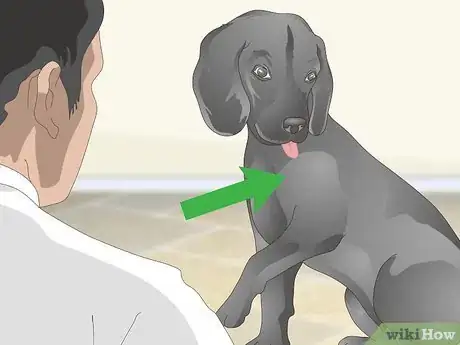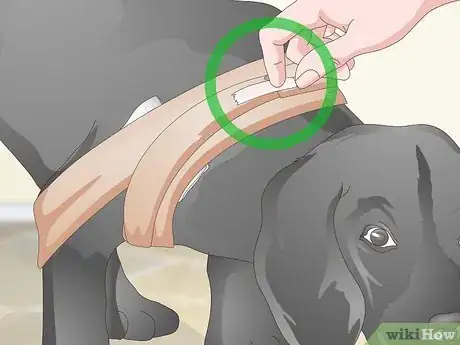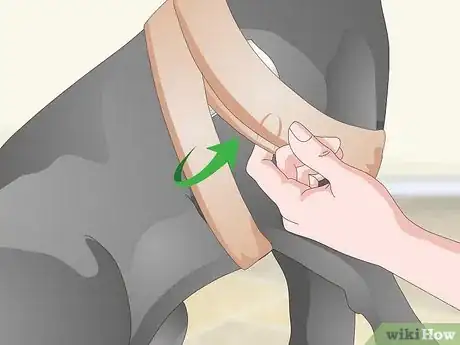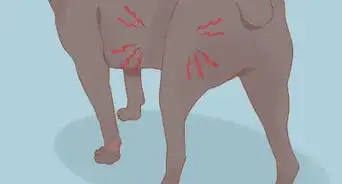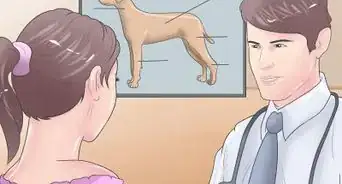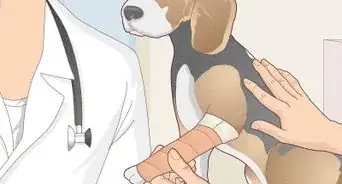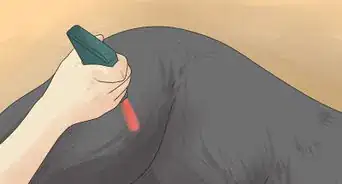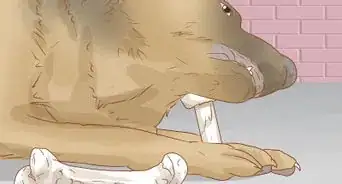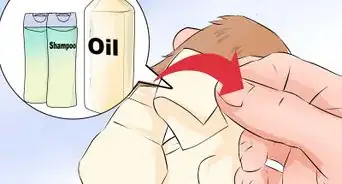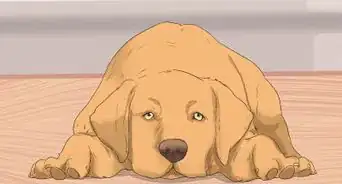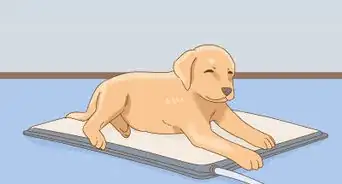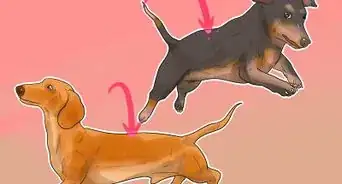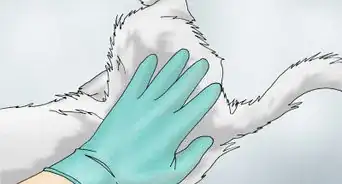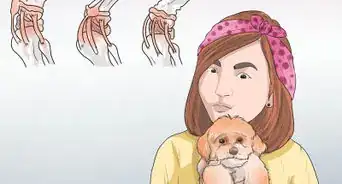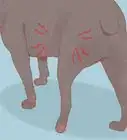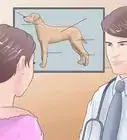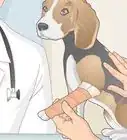This article was co-authored by Pippa Elliott, MRCVS and by wikiHow staff writer, Jessica Gibson. Dr. Elliott, BVMS, MRCVS is a veterinarian with over 30 years of experience in veterinary surgery and companion animal practice. She graduated from the University of Glasgow in 1987 with a degree in veterinary medicine and surgery. She has worked at the same animal clinic in her hometown for over 20 years.
This article has been viewed 52,984 times.
If your dog has a cut or bite on its shoulder, wrap it before taking your dog to the vet. Assess the situation to see if you have time to dress the wound. If you do, try to stop the bleeding of an open wound before you place a cotton bandage on it. Wrap the shoulder and chest to create a harness-type bandage. Then get your dog immediate medical attention.
Steps
Dressing an Open Wound
-
1Assess the bleeding. If your dog has a major cut or a wound that is bleeding profusely, it may be best to seek vet help immediately. While you are taking your dog to the vet or animal hospital, apply pressure with a clean bandage or towel. If there is a foreign object in the wound, do not try to remove it yourself.
- If the wound is not severe or bleeding quickly, you will likely have time to dress it before seeking vet help. If the wound is so minor that the dog is not scratching at it or paying attention to it, you may not even have to dress it. Just go straight to the vet.
- If the blood from the wound is coming out in spurts or is bright red, this could indicate arterial bleeding. Such bleeding can be life-threatening. Apply pressure to the wound and seek immediate help.
-
2Keep the dog in standing position. Ask someone to help keep the dog in place so you can bandage the wound and wrap the shoulder. The dog should be standing so you can wrap the bandage under the dog's torso.
- If the dog is in pain, it may snap or bite. Even a typically calm dog can bite out of fear when hurt. To avoid this, consider using a muzzle or having someone gently but firmly hold the dog's head and neck forward while you dress the wound.
Advertisement -
3Clean the wound. If possible, before you wrap the wound try to gently clean it with a saline solution and a clean gauze or cotton pad. You do not need to extensively clean the wound at this moment. Simply flush out the opening with the solution.
-
4Press a cotton bandage on the shoulder wound. Dab the wound gently with clean cotton gauze. Then cut a cotton bandage to fit the size of the wound and place it directly on the open wound. Press down firmly with 1 hand to slow any bleeding.[1]
- Consider wearing gloves to prevent introducing germs to the wound.
Wrapping a Dressed Wound
-
1Wrap an elastic bandage around your dog's torso and shoulder. Press 1 end of the elastic bandage on your dog's back near its shoulder. Pull the bandage down and under its torso before bringing it back up near the shoulder. Bring the bandage down over the covered wound and wrap it around the dog's leg to keep the bandage in place. Repeat this a few times to stabilize the shoulder.[2]
- Use moderate tension to avoid cutting off circulation.
-
2Wrap the bandage behind the dog's neck and under the torso. To create a harness-type bandage that secures the shoulder, pull the bandage behind the dog's neck and down onto its chest. Bring the bandage behind the leg of the affected shoulder and back up behind the dog's shoulder. Wrap the bandage around the leg a few times for support.
- You should see a V-shaped bandage on the dog's chest.
-
3Secure the bandage with medical tape. Pull off a few inches of medical tape and cut it. Tape the bandage in place along the dog's back so the bandage doesn't unwind. You may need to use a few pieces. If you don't have medical tape, you can use masking tape or another strong tape that you have around the house.
- Some bandages come with butterfly closures that secure the elastic bandage in place.
-
4Run your finger under the bandage to check the fit. Slide your index finger under the bandage near your dog's leg and chest. You should be able to easily slide your finger under the bandage from the shoulder down across the chest. If you can't, the bandage is too tight and you should wrap it more loosely.[3]
Seeking Veterinary Help
-
1Get your dog to a veterinarian as soon as possible. These instructions are only meant to help you provide immediate first aid when necessary. If your dog has a deep, bleeding wound or you suspect the dog has a shoulder fracture, it will need medical treatment.
- The vet will remove your dog's shoulder wrap to clean and examine the wound. The dog may need x-rays, injections, or stitches.
-
2Call your vet to let them know you’re on the way. It’s always prudent to call your vet before you actually walk through the doors. This way, if there is an emergency, someone knows you’re on your way and can meet you at the door. This also enables your vet to recommend another clinic if they are unable to accommodate your pet at that moment.[4]
-
3Tell the vet what you know about the wound. Once you arrive at the clinic, let your vet or one of the veterinary assistants know about the wound. Provide them with any information you have regarding how the wound happened and if you believe there are any foreign objects in or around your dog’s shoulder.
- Typically, you will be asked for this information as you check in or after you check in. They may begin emergency treatment on your dog before you have provided this information. That should not cause any additional worry.
Things You'll Need
- Gauze
- Scissors
- Cotton bandage
- Elastic bandage
- Medical tape
